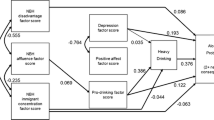Abstract
Two sequential studies are presented that examine the validity of a set of environmental variables to predict heavy drinking at college students' most recent drinking occasions. Random telephone interviews (n = 1609, n = 400) of graduate and undergraduate students attending two large public universities in the southwestern United States were conducted during three separate surveys in 2000 and 2001. An original interview schedule was used and it included measures that examined environmental characteristics of students' most recent drinking events, motivations for drinking, demographics, and alcohol consumption. Using nonparametric exploratory and confirmatory discriminant analyses to distinguish between heavy episodic and nonheavy episodic drinking events, a discriminant function was identified that included the following environmental variables: (1) having many people intoxicated at an event, (2) having illicit drugs available at an event, (3) BYOB events and, (4) the playing of drinking games at the event. The validity of these environmental variables to predict heavy drinking among students was supported in a subsequent study examining a separate sample from the same student population. Environmental factors can be useful to predict heavy drinking events experienced by students. Prevention programs would benefit from targeting such factors in combination with more traditional individual-level approaches.
Similar content being viewed by others
REFERENCES
Baron, R. M., & Kenny, D. A. (1986). The moderator-mediator variable distinction in social psychological research: Conceptual, strategic, and methodological considerations. Journal of Personality and Social Psychology, 51, 1173-1182.
Browne, M. W., & Cudeck, R. (1993). Alternative ways of assessing model fit. In K. A. Bollen & J. S. Long (Eds.), Testing structural equation models (pp. 136-162). Newbury Park, CA: Sage.
Clapp, J. D., Shillington, A. M., & Segars, L. (2000). Deconstructing contexts of binge drinking among college students. American Journal of Drug and Alcohol Abuse, 26(1), 139-154.
Clapp, J. D., & Shillington, A. M. (2001). Environmental predictors of heavy episodic drinking events. American Journal of Drug and Alcohol Abuse, 27(2), 310-313.
Clapp, J. D., Voas, R., & Segars, L. (2001). A conceptual model of the alcohol environment of college students: implications for prevention and evaluation. Journal of Human Behavior in the Social Environment, 5(1), 73-90.
DeJong, W., Vince-Wittman, C., Colthurst, T., Cretella, M., Gilbreath, M., Rosati, M., Zweig, K. (1998). Environmental management: A comprehensive strategy for reducing alcohol and other drug use on college campuses. Monograph of the Higher Education Center for Alcohol and Other Drug Prevention (unnumbered)
Demers, A., Kairouz, S., Adlaf, E., Gliksman, L., Newton-Taylor, B. & Marchand, A. (2002). Multilevel analysis of situational drinking among Canadian undergraduates. Social Science and Medicine, 55(3), 415-424.
Hair, J. F., Anderson, R. E., Tatham, R. L., & Black, W. C. (1992). Multivariate data analysis with readings. New York: Macmillan
Hansen, W. B. (1997). A social ecology theory of alcohol and drug use prevention among college and university students. In U.S. Department of Education, Designing alcohol and other drug prevention programs in higher education: Bringing theory into practice (pp. 155-177). Newton, MA: The Higher Education Center for Alcohol and Other Drug Prevention.
Harford, T. C. (1979). Contextual drinking patterns among men and women. In A. Frank (Ed.) Currents in alcoholism (Vol. 4). New York: Grune and Statton
Hilton, M. (1991). The presence of alcohol in four situations: Survey results from 1964 and 1984. In W. Clark & and M. Hilton (Eds.), Alcohol in America. New York: Suny Press.
Hilton, M. E. (1989). Public Drinking and drinking problems. Paper presented at the 117th Annual Meeting of the American Public Health Association, October 22-26, Chicago, IL
Johnston, L. D., O'Malley, P. M., & Bachman, J. G. (1998). National survey results on drug use from the Monitoring the Future Study, 1975-1997, Volume II. (NIH Publication No. 98-4346). Rockville, MD: National Institute on Drug Abuse.
Lange, J. E. & Voas, R. B. (2000). Youth escaping limits on drinking: Binging in Mexico. Addiction, 95(4), 521-528.
Midanik, L. T. (1988). The validity of self-reported alcohol use: A literature review and assessment. British Journal of Addictions, 83, 1019-1030.
Muthen, B. O. (1989). Dichotomous factor analysis. Sociological Methods and Research, 18(1), 19-65.
Muthen, L. K. and Muthen, B. O. (1998). Mplus user's guide. Los Angeles, CA: Muthen & Muthen.
Pedhazur, E. J. and Schmelkin, L. P. (1991). Measurement, Design, and Analysis: An integrated approach. Hillside, NJ: Erlbaum
Presley, C. A., Leichliter, J. S., & Meilman, P. W. (1998). Alcohol and drugs on American college campuses: A report to college presidents (Report Monograph). The Core Institute, Southern Illinois University, Carbondale, IL
Presley, C. A., Meilman, P. W., & Lyerla, R. (1995). Alcohol on American college campuses: Use, consequences, and perceptions of the campus environment, (Vol. 2). The CORE Institute Student Health Programs, Southern Illinois University at Carbondale, Carbondale, IL
Ryan, B., Colthurst, T., & Segars, L. (1994). College alcohol risk assessment guide. University of California San Diego Press, San Diego
Stokols, D. (2000). Creating health-promotive environments: Implications for research and theory. In M. Schneider & D. Stokols (Eds.), Promoting human wellness: New frontiers for research and practice. Berkeley: University of California Press
Straus, R., & Bacon, S. (1953). Drinking in college. Binghamption, NY: Yale University Press.
Treno, A. J. & Holder, H. (1997). Community mobilization: An evaluation of an environmental approach to local action. Addiction 92(Special supp. 2) s173-s187
Wechsler, H., Kuo, M., Lee, H., & Dowdall, G. (2000). Environmental correlates of undergraduate alcohol use and related problems of college students. American Journal of Preventive Medicine, 19(1), 24-29.
Author information
Authors and Affiliations
Rights and permissions
About this article
Cite this article
Clapp, J.D., Lange, J., Min, J.W. et al. Two Studies Examining Environmental Predictors of Heavy Drinking by College Students. Prev Sci 4, 99–108 (2003). https://doi.org/10.1023/A:1022974215675
Issue Date:
DOI: https://doi.org/10.1023/A:1022974215675




